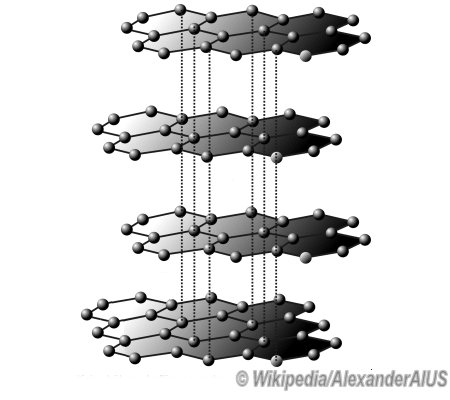
|
Miracle-material Graphene

It is still very difficult to judge, just which problems the miracle-material Graphene, which was discovered about 50 years ago, would solve, indeed, there would prove to be quite a few. Ever since the two scientific
researchers, Geim and Novoselev, won the Nobel Prize for physics in 2010, this material, which carries so much hope, may be more well known among the general public.
As the name suggests, Graphene originates from Graphite, more precisely, as a structure, with a width of one atom, made up of six-sided honeycombs. We're talking about around 0,3 nanometers (nm), which would
mean 1/3.000.000 of a mm. This is 1/1.000.000 the thickness of paper and ten times smaller than the structure of chips which are created on the basis of the wafer-production. Not only cell- and smartphones would
benefit from reductions of this magnitude.
Nonetheless, this inconceivably thin layer would have to carry masses in the kilogramm range. At the latest, the mechanical qualities should stimulate the fantasy of those with an interest in the automobile field. If one
then also hears about the relatively simple transfer technology from a graphite block using adhesive tape and a silicon oxide substrate, the future car-body builders must prick up their ears. Indeed, up to now, all this
only works in miniscule amounts under laboratory conditions.
Indeed, these are the ups and downs of pure research. Researchers work on objects whose effects on technical development are completely unknown. For example, the electrical properties of Graphene. It conducts
current 50 times faster than copper. The possibility for the production of transistors, the basis of almost every integrated circuit, will possibly, also be revolutionised. Apart from the perhaps simpler manufacturing and
miniaturisation, three switching positions instead of two would then also be possible.
As yet, we haven't even mentioned the excellent transparency of the new material. Imagine how it could be used for flat-screen monitors, even possibly for Touchscreens. Perhaps as solar-panels, not only for roofing,
but also integrated into window panes, maybe with an even higher efficiency than the one's used nowadays. Of course also as actuators, e.g., allowing a precisely adjustable degree of shading.
Finally, the aspect of procuring the raw material. Think about what's necessary to obtain the substances needed for the modern chip- and display production. Indium e.g., whose deposits are distinctly lower than that
of crude oil. Quite apart from the energy saving and procurement of the substances, think also about the operation of devices using the new miracle material. 07/11
|
|